If you are visiting Bijagua in Costa Rica’s Northern Zone, you are probably already looking for an authentic experience. Within the small town are quaint local restaurants and farm fields that extend to the edge of the thick jungle. Wildlife and local culture are abundant. Nearby, you’ll find one tourist hotspot, the Rio Celeste Waterfall, but other activities are more low-key and personalized. The Tapir Valley, a nearby private nature reserve, fits that description well. In this post, we share our experience on the Tapir Valley Reserve night tour.
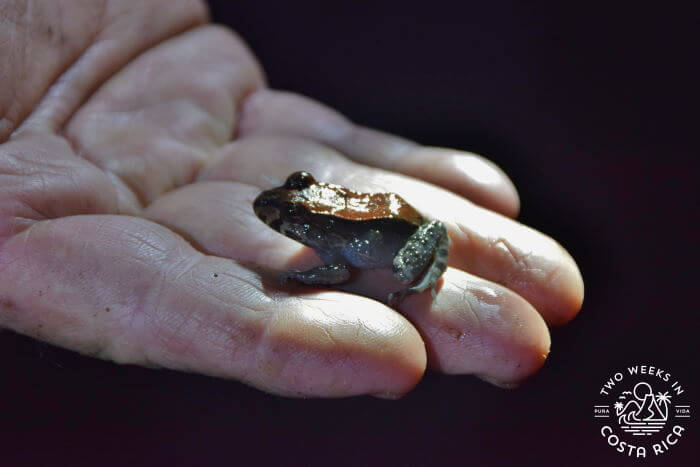
What is the Tapir Valley?
The Tapir Valley is a 220 acre (81 hectare) private reserve located between the town of Bijagua and entrance to Tenorio Volcano National Park. Tenorio Volcano National Park is home to the bright blue Rio Celeste Waterfall.
The property was purchased by two locals, who saw the value of the land for conservation purposes. They decided to protect it and share it with others who share similar passions.
The Tapir Valley, as the name implies, sits in a large valley. The dormant Tenorio Volcano, more of a verdant green mountain, forms the backdrop. The surrounding slopes are thick jungle. The lowest points have small streams and a large, pond-like wetland.
Since the reserve is private, it does not have a lot of foot traffic. All tours and visits are arranged through the property’s website.
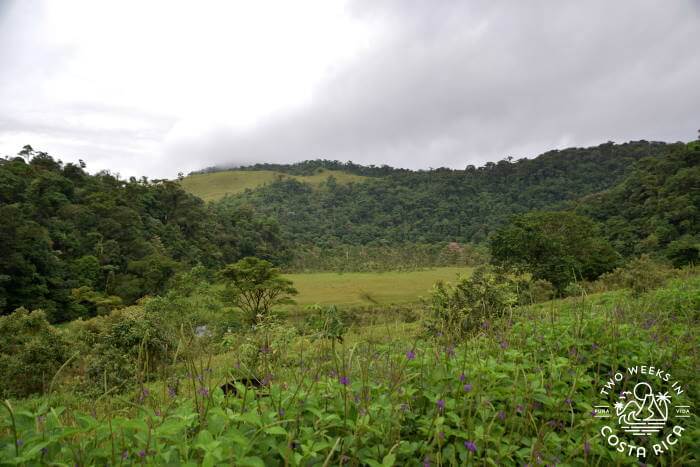
An Incredible Ecosystem
With habitat varying from lofty primary rainforest to tangled underbrush and grassy swamp, the Tapir Valley is home to thousands of different plants and animals.
Birding is especially good here, but something unique is the presence of Costa Rica’s largest land mammal, the Baird’s Tapir.
These shy animals sort of look like a small hippo, with a short, curved trunk. Tapirs are somewhat rare in Costa Rica and live only in areas with expansive, undisturbed forest.
As we quickly found out on our night tour, the Tapir Valley also may be also a herpetologist’s dream property. We saw several different snakes and so many frog species that we eventually lost count.
The Tapir Valley Night Tour – Our Experience
Our night tour started around 4:00 p.m. at the entrance gate to the Tapir Valley. Here, we met our guide, Jorge, a friendly local from the area.
Jorge helped us park and brought us over to the Tapir Valley’s Welcome Center. The small building had bathrooms and benches for us to get fitted with rubber boots. We also took some extra time to apply lots of insect repellent, as the mosquitoes were starting to get thick.
Note: This property has a lot of mosquitoes. Read the Tips for Visiting section, below, for some recommendations on clothing and repellent.
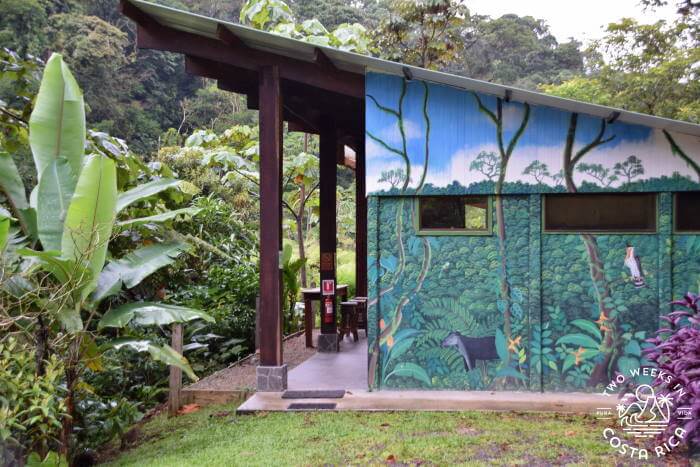
Hitting the Trail
After an introduction to the property and what we would be doing that night, Jorge started down one of the grassy trails.
This part of the reserve was nicely landscaped, with flowering plants and native trees dotted in. It wasn’t long before we were learning about some of the native plants important to the area.
There was the Bijagua or rattlesnake plant (which is how the town of Bijagua got its name), cana agria (a wild, sour version of sugarcane), and balsa trees (known for their lightweight wood).
Perched under a beautiful heliconia flower, we also saw our first snake of the evening. It was an eyelash pitviper.
These venomous snakes can be all sorts of different colors, but this one was a patterned green and white. It was coiled up, waiting for a hummingbird or some other small animal to feed from the large flowers.
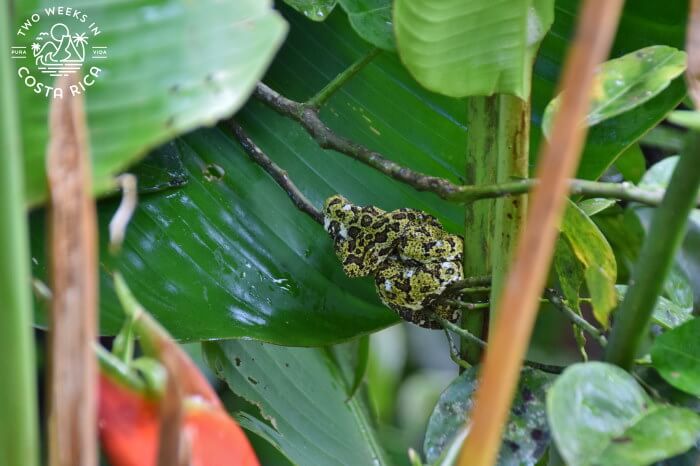
The Middle Forest Path
With Jorge in the lead, we wound through the gardens, past a long field and then over a small bridge into the deeper woods.
The Tapir Valley has several different trails. Jorge first took us along the middle forest path. He let us know that he was leaving the trail closer to the wetland for later, since it would have more activity after dark.
As we walked in the twilight, our trusted guide was constantly stopping to point out different things. There were golden orb spiders, marching leaf-cutter ants, stick bugs, and many types of frogs. We learned a lot about each one from Jorge.
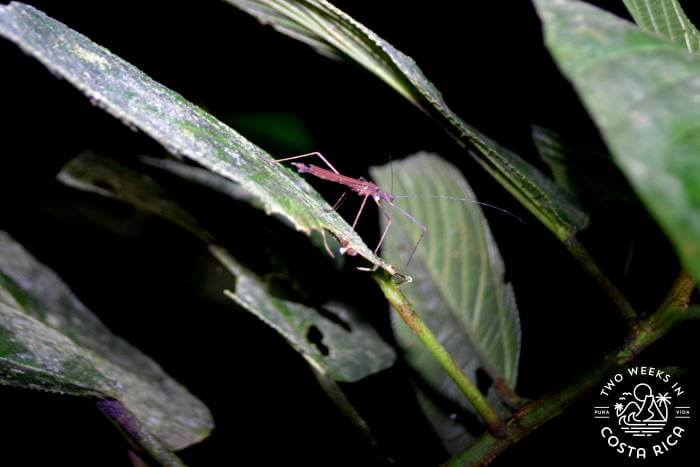
The Wetland View Platform
Soon we made it to the Wetland View Platform, near the middle of the property.
From the wooden deck, we took in the view of the gorgeous valley with the swelling wetland just below.
Here, we met up with Donald, one of the founders of the property and co-owner, with his wife Pip, of the nearby Casitas Tenorio B&B.
Donald and a university graduate student were all decked out, wearing their field gear, and getting ready to head into the swamp. They were doing some top-secret research on the local frog species, collecting data and taking lots of photos and videos.
Over some fresh fruit, cookies, coffee, and juice, we learned a little about their work while the sun fell. The hum of night in the rainforest intensified.
Hiking After Dark
Fueled with coffee and fitted with some high-tech headlamps, we were ready for the next part of the hike.
Now it was completely dark. After a recent nerve-racking experience on a night tour in La Fortuna, the kids stayed close to our guide on the trail. Our youngest was propped up in a backpack carrier.
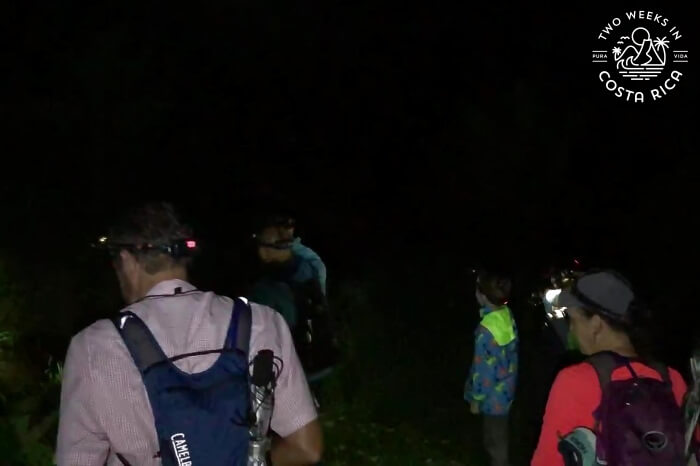
This section of trail passed through different parts of the property’s lowest areas. The ground was wet and sticky, and the sound of frogs chirping and croaking was almost unreal.
Highlights from Our Night Tour
Frogs
Like we mentioned earlier, the number of frog species living in the Tapir Valley is incredible. In just our short tour, we probably saw close to a dozen different types.
Some of the coolest ones were the famous red-eyed tree frog, which were abundant, the red-webbed tree frog, common Mexican tree frog, Central American bullfrog, and brilliant forest frog.
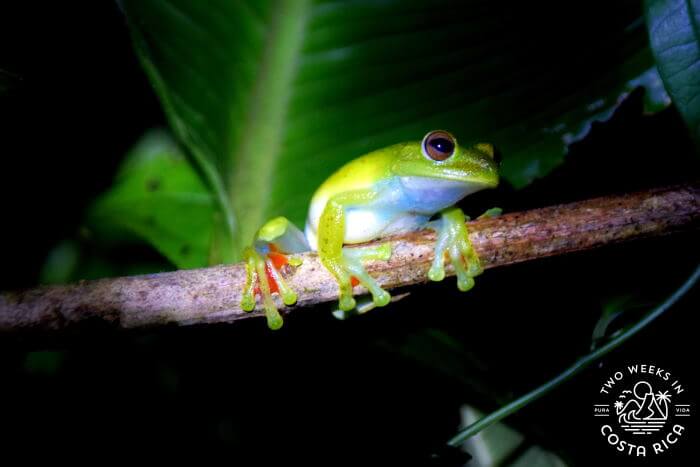
At one place on the trail, we also got to meet up again with Donald and the grad student who were busy doing their fieldwork. It was fun to see in person how they were monitoring the frogs to learn more about them and their lifecycle.
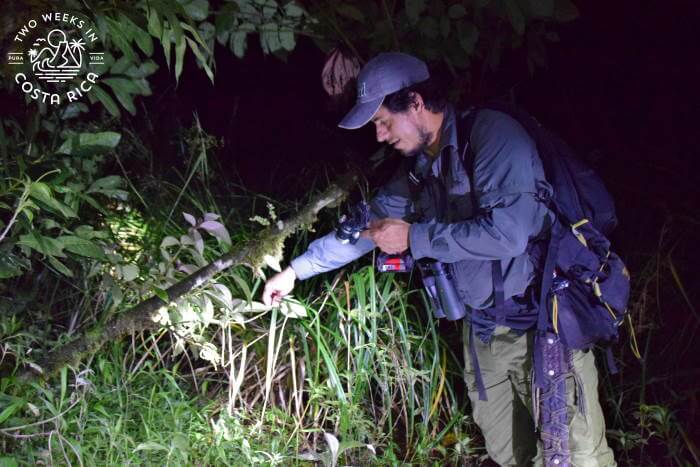
Snakes
Another highlight were the snakes. In addition to the eyelash pitviper at the start of the trail, we also spotted a coral snake slithering under a log.
Later in the night, we encountered two different fer-de-lances. These snakes are considered one of the most dangerous in Costa Rica. They are abundant and responsible for most of the snakebites reported in hospitals here.
We were fortunate to observe all the snakes from a safe distance, with our guide making sure no one got too close.
Tracking Tapirs
It was our hope to see a Baird’s Tapir at some point during the night. Of course, nothing is guaranteed, but we had seen signs of them early on. Right at the entrance to the property there were large piles of tapir dung from the night before.
On our way back to the Welcome Center, we also found fresh Tapir tracks in the mud. Donald and Jorge did their best to follow them as we quietly scanned the jungle with our headlamps. But as we got back to the entrance, the tracks led across the road and into the darkness. No Tapir sighting this time but tracking them was exciting on its own.
Other Wildlife
Besides snakes and frogs, we also were lucky to see some other cool animals during the night tour.
There was a baby Tanager bird, perched in a short shrub. It must have fledged the nest too early and found the safest spot it could for the night.
Later, our headlamps caught the shining eyes of two little rabbits. They were hiding from us in the long grass.
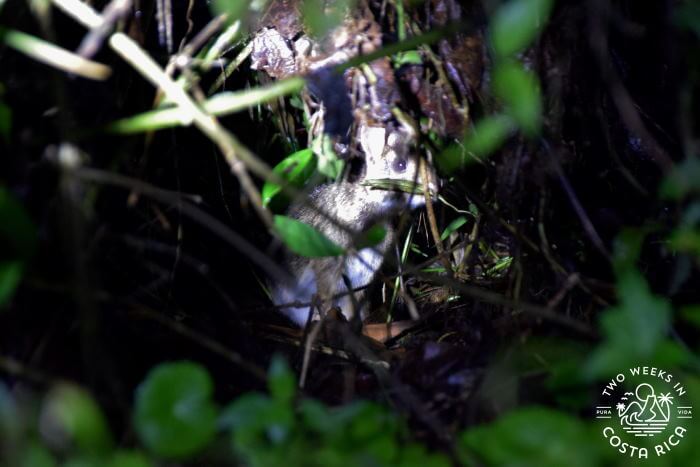
We also saw a very shy paca hiding in the bushes. Pacas are a large type of rodent with brown fur and white spots. They have a similar pattern to a baby deer.
There were also giant grasshoppers, land crabs, moths, sleeping butterflies, and lots of spiders and interesting insects.
Reflections on an Adventurous Night
The Tapir Valley night tour was an adventurous experience and completely unique. We have done many night tours around Costa Rica and this one stands out as one of the wildest we have done.
The jungle and wetland areas of the Tapir Valley seemed so far removed from human contact. With the narrow beams of our headlamps catching only a sliver of the amazing ecosystem, we left feeling humbled and inspired by its raw nature.
Tips for Visiting the Tapir Valley
What to Bring
It is important to be prepared for this night tour.
Entrance includes rubber boots and a headlamp, but be sure to wear long pants and a long-sleeve shirt or raincoat. There are many mosquitoes, and it often rains at night in the jungle. Clothing covering your skin will be very helpful and make you a lot more comfortable.
If you can, invest in some mosquito-repellent clothing (see our recommendations here), or at least bring some good repellent. Here is a link to our post on Mosquitoes in Costa Rica. It has recommendations for repellents towards the bottom.
Also be sure to bring a small backpack with extra water and snacks. A rain cover for your camera is also handy.
Get your camera’s extra batteries charged up, as taking pictures in the dark can really drain them (depending on your settings, of course).
Booking a Tour
The Tapir Valley offers birdwatching tours, night tours, and family-nature tours. The family tours can be done in the morning or at twilight.
Twilight tours are nice because they start in the late afternoon and go into the early evening, so you get a mixed experience. We opted for this because of the kids and it worked out well. Others may want to start a bit later to experience even more during the darker hours.
You can contact the Tapir Valley directly through their website to arrange a tour.
Have a question about visiting the Tapir Valley or want to share what you saw on a night tour? Leave a comment below.
Looking for more information to help you plan a unique trip to Costa Rica? Check out these posts:
9 Off-the-Beaten-Path Destinations in Costa Rica – Find places a bit off the tourist trail but still with plenty to explore and do with this short list.
The Enchanting Rio Celeste Waterfall – Just down the road from the Tapir Valley, this baby blue waterfall is one of the most impressive in Costa Rica.
Rental Car Discount – When visiting remote spots, a rental car gives you freedom to explore. Check out our Rental Car Discount page to save a bit and get free extras.
